06 February 2023 | Marketing
1 reason why your memes suck
By
“I get paid to make memes.”
That’s my (half joking) response whenever somebody asks me what I do for a living. I should really work on my elevator pitch… ‘cause this gives off ‘lives-in-moms-basement” vibes.
But I take pride in my memes. Memes are one of the most powerful weapons you have in your as a social media manager. As a marketer in general, really.
And done right, they can have a massive impact on your brand’s social media growth.
One problem:
A lot of social media managers misuse memes.
The mistake is super subtle… but it’s the difference between a banger and a dud that you wanna delete 10 minutes later because the engagement is so garbage.
Today I’m gonna walk you through the 2 types of memes, when to use each, and of course — the mistake you need to avoid.
But first… why memes?
1) Memes communicate better than words can. You know the say “a picture is worth a thousand words?”
Well… a meme is worth a million (source: trust me bro).
Just look at this example from from Triple Whale account:
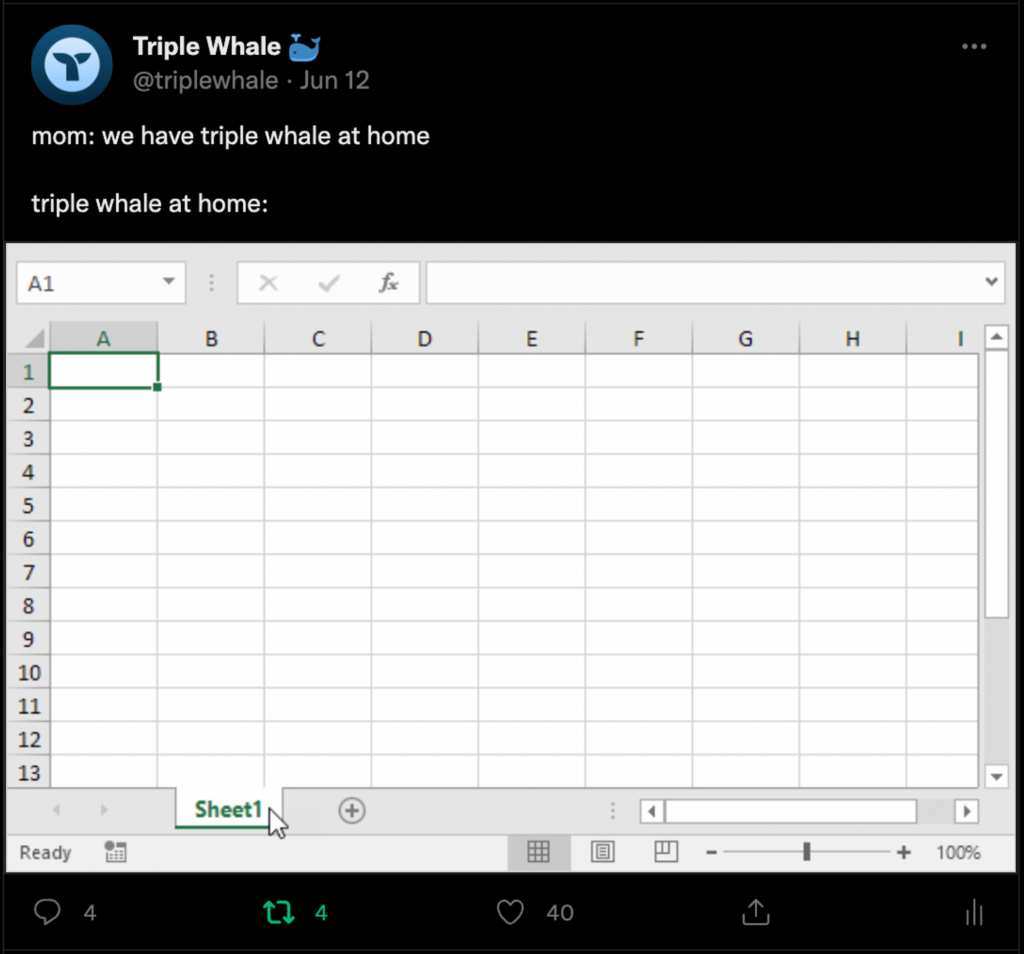
I could have wrote a tweet or a thread on how our dashboard is more effective than using Excel to keep track of your marketing metrics. Yawn. That would be boring.
Instead I used this meme to communicate that message in a much more engaging way.
2) Memes are inherently shareable. As a social media manager, you already know: native content wins on social platforms.
The best brands don’t constantly link out — they give their community great content made for social.
Memes are great for this.
3) Memes allow you to test and scale at a rapid pace… no matter the budget.
A meme that took you 17 seconds to make might get wayyy more engagement than a highly produced piece of content.
I’m NOT saying highly produced content isn’t valuable — it has it’s place.
But memes give you the opportunity to test over and over and over again, without much cost (except for the hours spent scrolling Reddit for templates LOL).
Make sense?
Now, let’s break down the 2 main types of memes you’ll be using from the brand account…
1) Product-related memes
Product-related memes make a joke explicitly mentioning your product.
Here’s an example from the Triple Whale account:
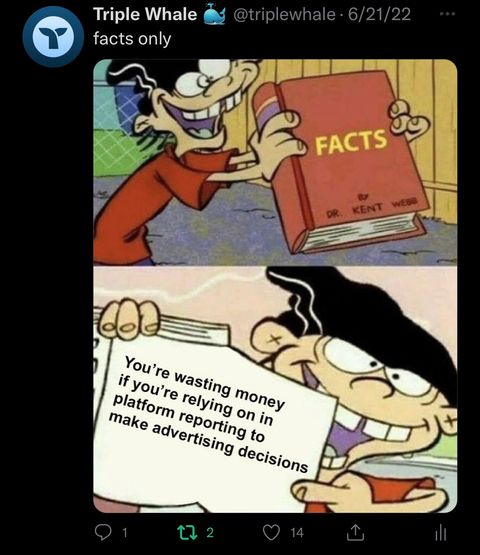
These are fantastic for:
- Highlighting a product feature
- Making comparisons between your product and competitors
- Illuminating pain-points that your product solves
Remember — a good meme is worth a million words 😉
And a well-crafted meme can convey the benefit of your product even better than a thousand word blog post
(Bonus tip: use memes as imagery in your blogs to make them easier and more entertaining to read. Thank me later)
The one downside to product-related memes is they generally get lower engagement than other memes.
Take a look at this meme, for example…
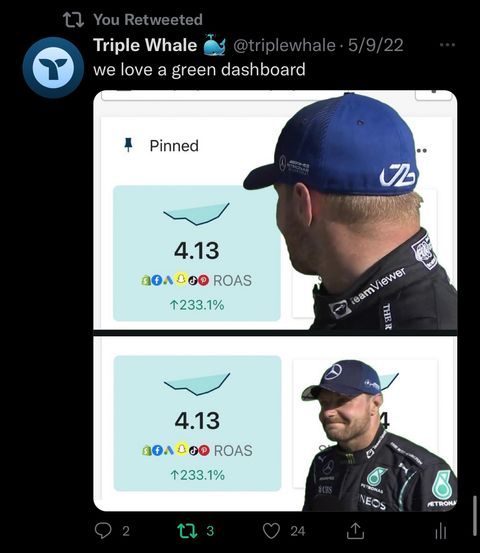
It does a good job highlighting a product feature (our 🔥 dashboard). And it did okay, but this engagement isn’t blowing anyone away.
The good news?
Product-related memes don’t need to get amazing engagement. This second meme type solves for that.
2) Industry-related memes
Industry-related memes make a joke about something in your brand’s niche — but don’t explicitly mention or promote your product.
This is the secret sauce. This is where the crazy engagement comes from. This is how you give people in your niche a reason to follow you.
Why?
These memes speak to a broader audience. One that might not know about your product yet (but is in your target audience).
So… these memes help you get in front of new people that could be customers at some point.
Here’s an example of an industry-related meme that performed well on the Triple Whale account:
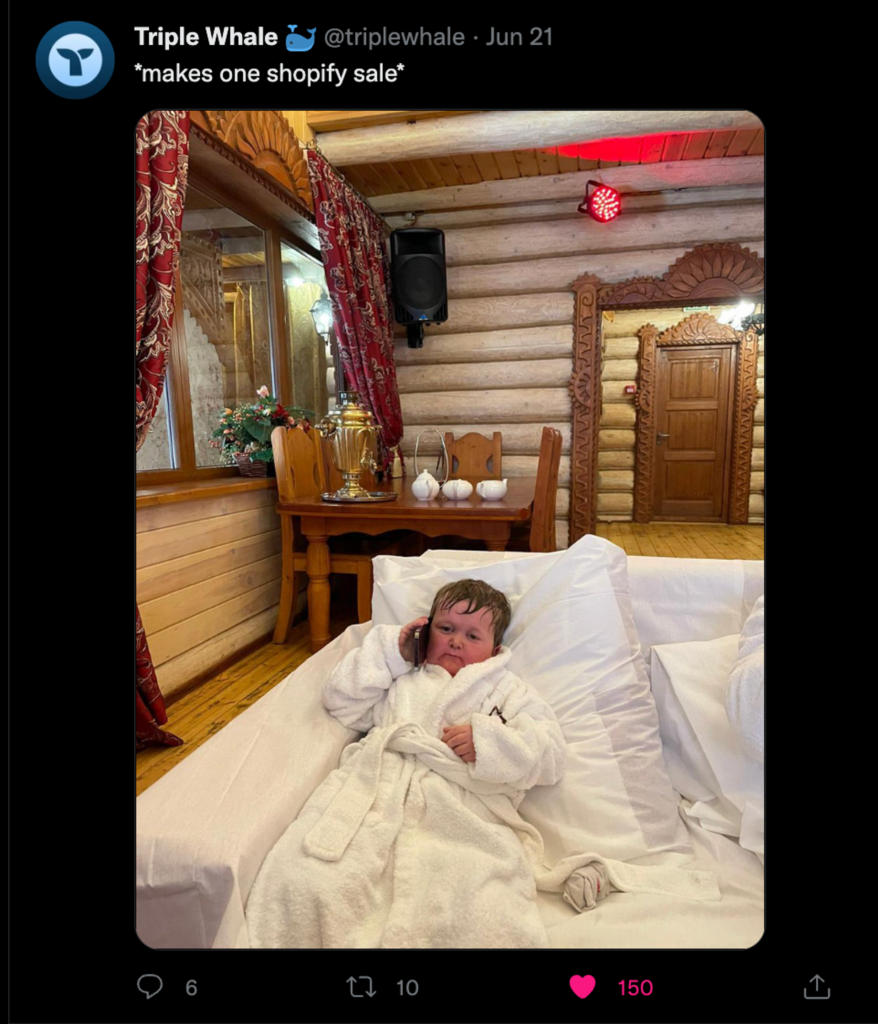
This got 150 likes — significantly more than the product-related meme I highlighted earlier.
See how this meme doesn’t explicitly talk about our product, but is relevant to our target customer (ecommerce marketers for brands on Shopify)?
You don’t want to go too broad and sacrifice quality for the sake of empty engagement. But you do want your meme to have wide enough appeal that it gets seen outside of your core group of followers (they already care about your brand).
Industry-related memes are great for making fun of pain-points people in your target audience face.
One of my favorite questions to generate meme ideas is:
“What’s something people in my target audience want to rant about, but can’t?”
Creating a meme that answers this question allows your target audience to “vent” about pain points without taking responsibility for the take — this incentivizes retweets and shares.
Here’s one meme where I used this thinking:
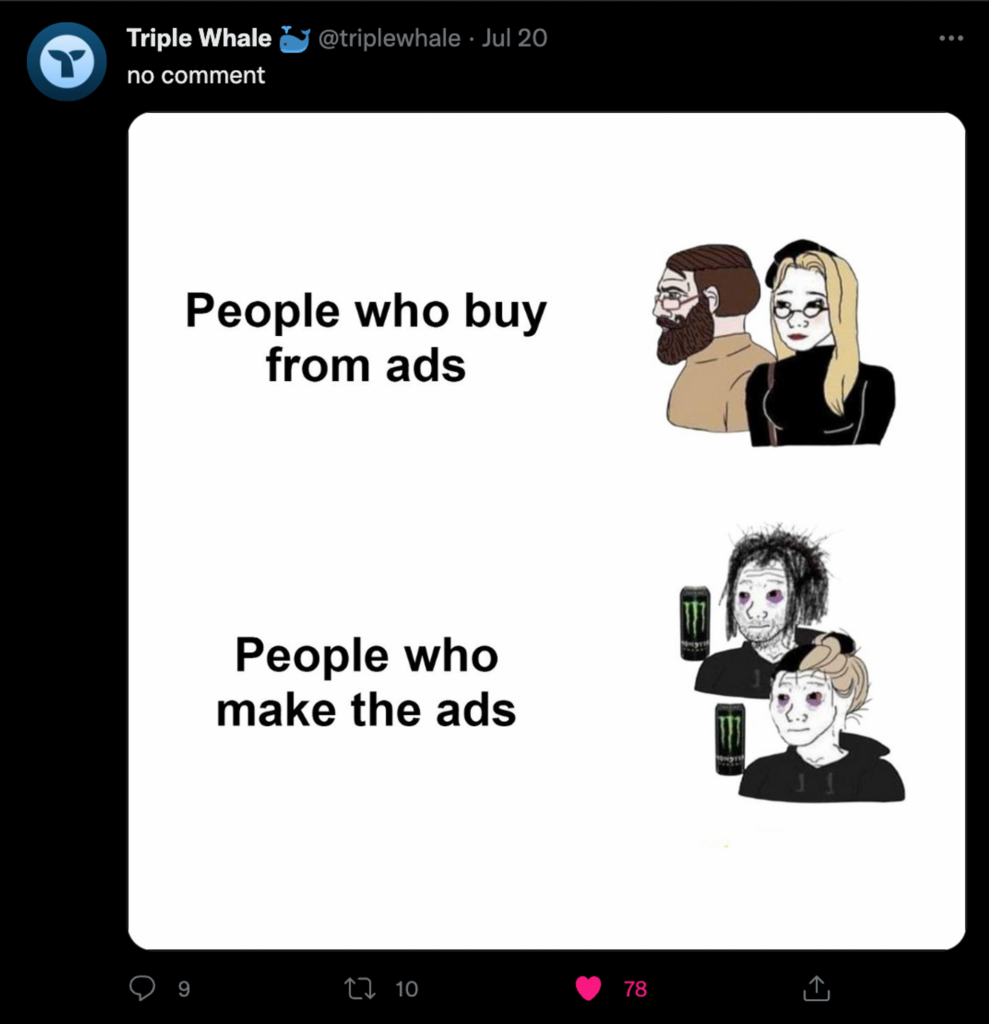
Here was my thought process when making this meme:
Let’s be real. Too many marketers are anxious, tired, and over-caffeinated. But most of them aren’t taking to Twitter tweeting about it all the time.
It’s uncomfortable. Their boss might follow them. It might not be their thing to use Twitter to vent (totally healthy behavior by the way 🤣).
But they will retweet + share a meme that expresses this pain point in a humorous, harmless way.
Thus, the meme got good engagement compared to baseline.
Here’s another example from Launch House that went absolutely bonkers:
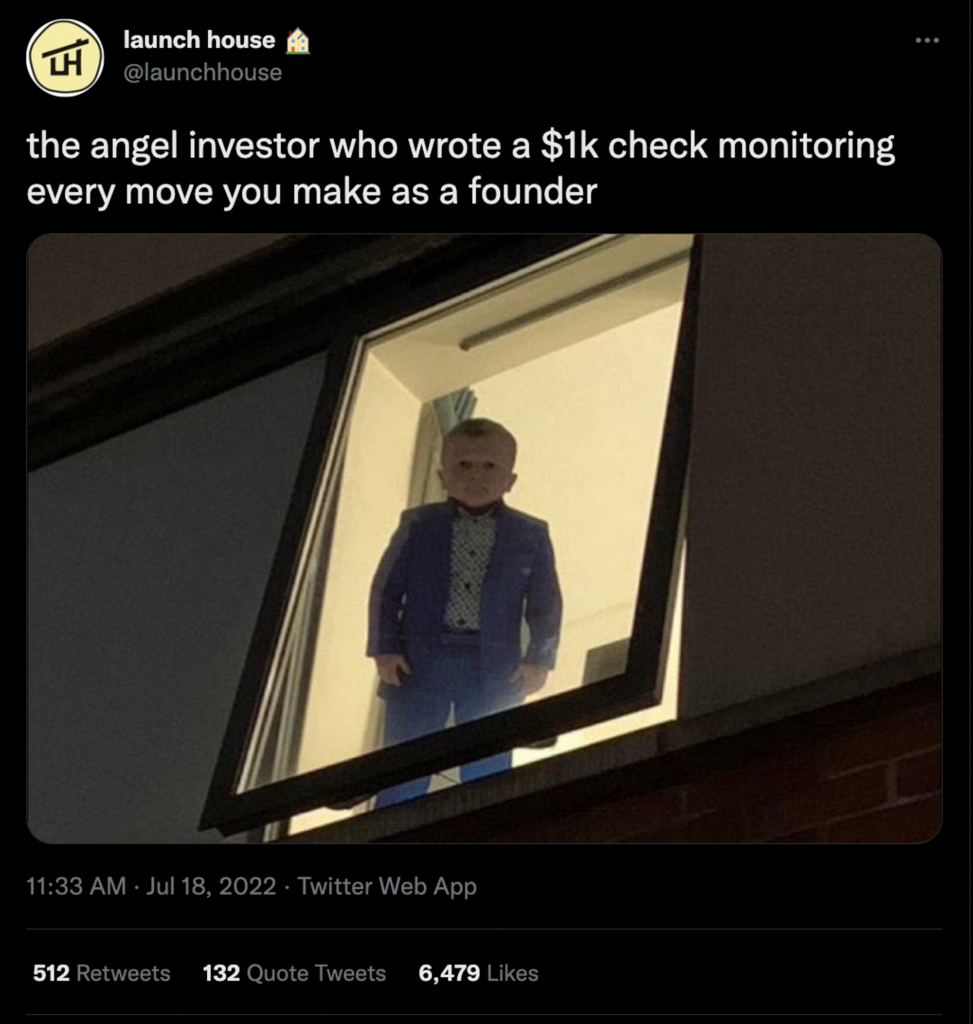
Video game numbers. Why?
Again, they put a super common complaint from their target audience (micro-managing VCs) into meme format — making it easy (and pretty safe) to share.
And here’s another pro-tip for your meme creation process 👇
The best memes (and content in general) pass the ‘group-chat test’ (credit to the legend Nik Sharma for coming up with the name).
What’s the group chat test? 💬
People in your target audience should be sending them in text chats, Slack channels, etc. This is hard to measure on some platforms, but it’s a good overarching goal to have when ideating memes.
Think about what type of memes you share with your friends?
You’re sending funny sh*t that you relate to… and probably not something that’s specifically selling a product.
See how that works?
There are exceptions to the rule, of course. But this holds up well.
Now, of course, industry-related memes aren’t perfect. They have their own flaws — the main flaw being that they don’t do a great job ‘selling’ your product.
Remember:
Vanity metrics are cool. Revenue is cooler. 💰
These types of memes are a foundational piece of any social strategy, but can’t be the ONLY piece (just like product-related memes wouldn’t do great on their own).
Now, let’s talk about this mistake I mentioned at the beginning of this piece 👀
An unfortunate mistake
I see this mistake all the time. It breaks my heart 💔
What is it?
Only relying on ONE of these two meme types in your social strategy.
Usually, social media managers fall into the trap of sticking to product-related memes.
And their engagement is 🗑
Why?
It’s no mystery. Even in meme format… your audience doesn’t care about your product that much. You’re putting too much faith in them LOL.
Remember, 99.99999% of people aren’t logging onto social to keep up with YOUR product. They’re logging on to be entertained, to keep up with their friends, etc.
Assuming people care about your product more than they actually do is a cardinal sin of content creation.
This is why you can’t survive off of product-related memes alone. You’re limiting your engagement by speaking to the super small % of your audience that actually cares deeply about your product.
So why do SMMs cling to these boring memes?
Simple. They’re safe. They’re also easier to explain to leadership who might be on the fence about memes in the first place.
They think they’re using memes as part of their social strategy, but this subtle difference in meme types is stunting their growth.
And look. Industry-related memes do harbor more risk. You’re not “selling” your product (leadership screams: what about the business metrics?!?).
One wrong move and your brand image gets thrown in the mud. Remember that guy who tweeted about eating a$$ from the PBR brand account? Yeah…
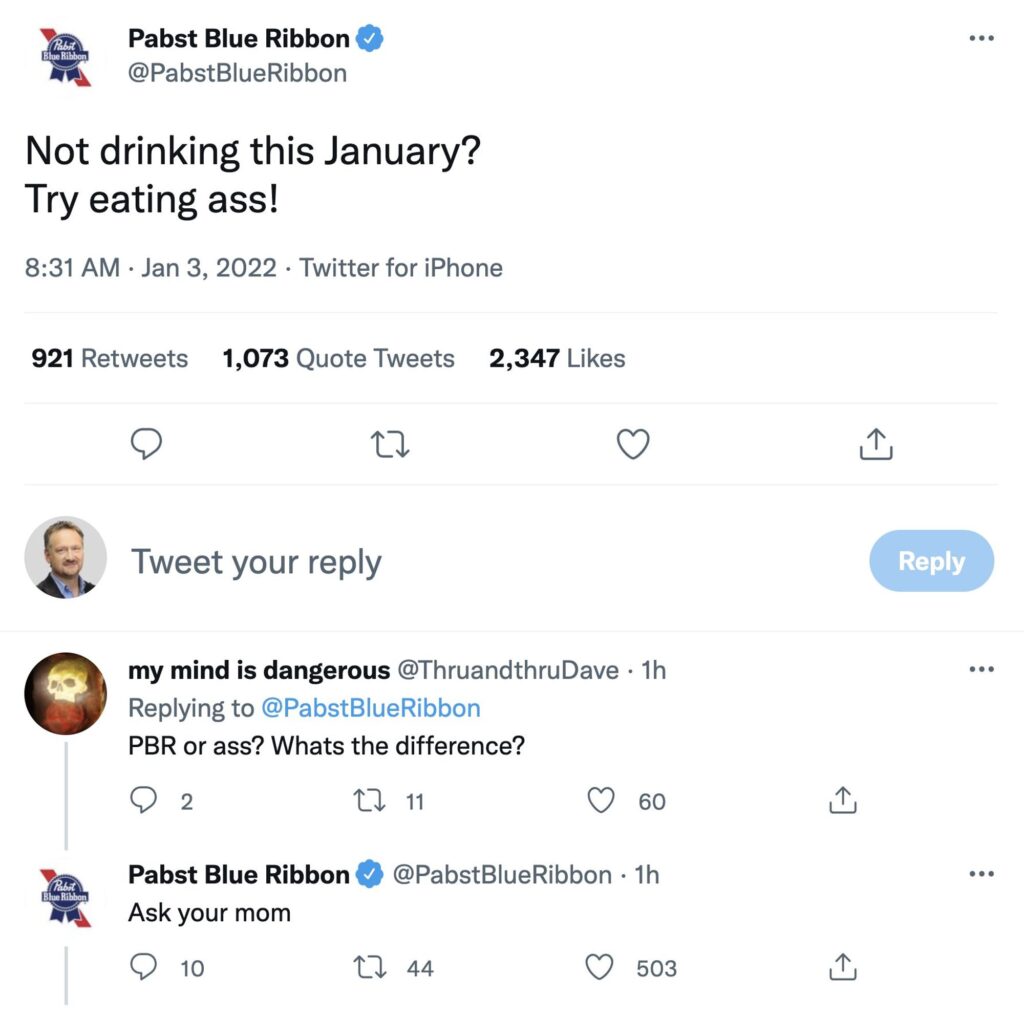
But you know the classic saying:
You gotta risk it for the biscuit (just not that much). And look… most social media managers are competent enough to not get the brand canceled. I have faith in you. LOL.
Now let’s pause for a second.
I want to make something clear:
The main lesson in this piece is NOT to ditch product-related memes. They’re important, in their own way.
Here’s the actual solution:
Include a combination of both product and industry-related memes in your social media strategy.
Understand the purpose of both.
a) Product-related stuff is speaking to a more core group of followers who are considering purchasing. So the posts might (and probably will) get less reach + engagement. That’s fine.
b) Industry-related stuff is speaking to a broader audience on social. So more people will resonate (aka find it funny) — and these posts will get more reach + engagement most of the time.
One type of content is meant to expand your audience. The other is meant to move people already in your audience closer to buying your product.
Understanding the purpose of both types of memes allows you to use them appropriately. And most importantly — it allows you to stay level headed and not freak out over discrepancies in metrics.
So it’s not one or the other — it’s both in the right balance.
That’s all I’ve got for you on meme types today.